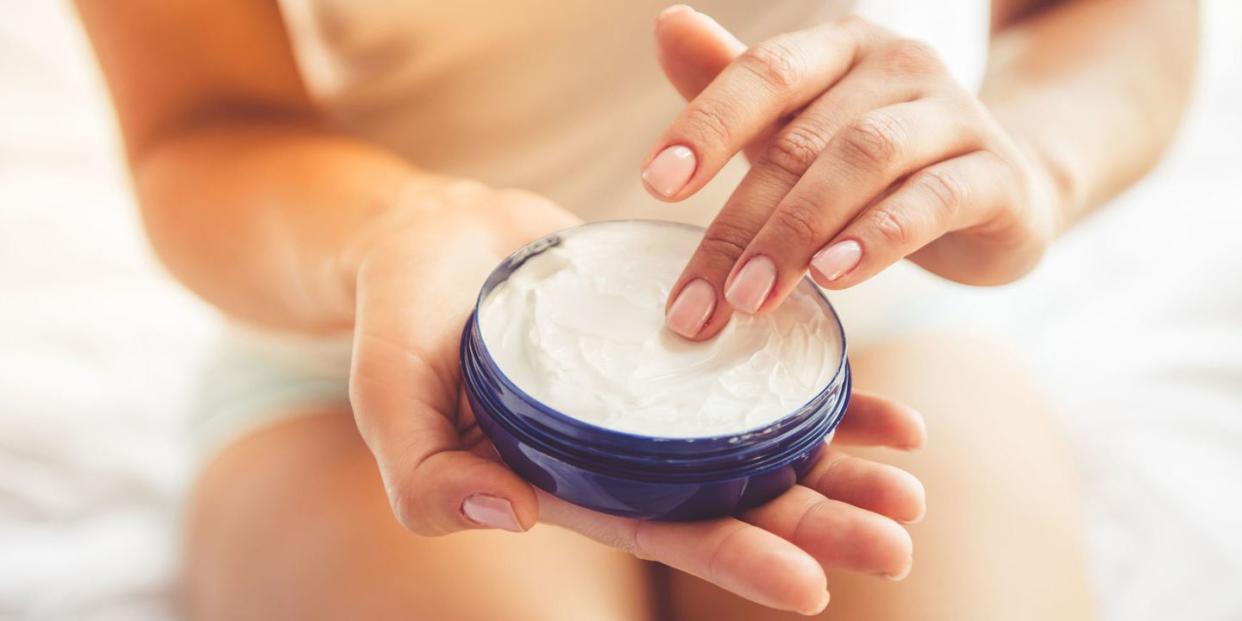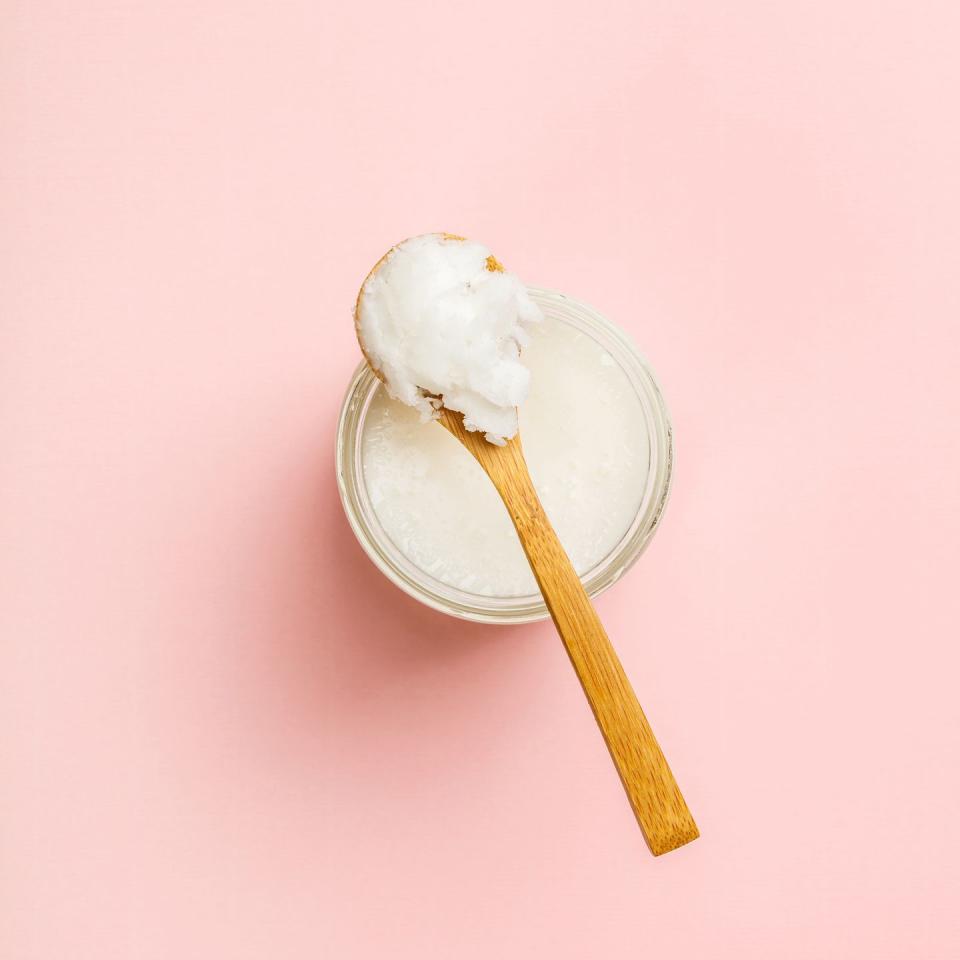If You Have Eczema, You Should Only Be Using Lotion That Comes in a Tub

Eczema may pop up unexpectedly, but it always has its signature warning signs. First, an inflamed red patch appears on your elbows, knees, or hands. Then, the unbearable itchiness leads to scratching — and that scratching inflames the skin even more. A whopping 31.6 million Americans suffer from eczema — that's more than 10% — but no matter how common it is, this group of medical conditions can still pose a challenge. While "eczema" actually breaks down into specific types, the most common kind, atopic dermatitis, is also a chronic one.
"It has to do with immune dysfunction," explains dermatologist Tina Bhutani of the University of California, San Francisco Medical Center. "Patients have an overactive immune system in addition to having a defect in their skin barrier." That biological difference makes the skin both drier and more susceptible to allergens and irritants in the environment, triggering flare-ups.
While dermatologists don't know the singular cause of every kind of eczema, they're clued into a few known activators and irritants that could put you at risk, says dermatologist Joshua Zeichner, MD, the director of cosmetic and clinical research at the department of dermatology at Mount Sinai Hospital in New York. The environment and air around you can obviously impact your skin: Cold, dry weather in the winter (as well as harsh winds) can "disrupt" your skin's outermost layer, Zeichner says.
Whatever type of eczema you're dealing with, there is no definitive "cure." Doctors will often prescribe an oral or topical medication to help soothe inflammation, right after most patients often turn to over-the-counter relief in the hopes of quelling mild cases. The best eczema creams and topical treatments are free of irritants (from scents to glycol acid) and often includes a high amount of ceramides, which are fatty lipid molecules that help moisturize skin. Cindy Wassef, MD, a professor at Rutgers University's Center for Dermatology, says that if you turn to over-the-counter treatments and don't see improvements within two weeks, it's time to head to your primary care provider or seek out a dermatologist.
Dr. Bhutani says the number one question she gets from patients is, "What else can I do?" Luckily, understanding your first line of defense is quite simple. Gentle skincare and a few lifestyle changes may give your body the TLC it needs to get back on track. That dreaded "itch-scratch cycle" might end sooner than you think; find sweet relief with her tips below.
1.Check your elbows before anything.
You might be able to tell a serious case of eczema apart from occasional itchy skin by where the rash pops up. Shari Sperling, DO, a New Jersey-based dermatologist who practices at St. Barnabas Medical Center, says that there are two common areas on the body that are most often affected. "Eczema shows up more in patches, more commonly behind the knees and inside of elbows as well as on cheeks for babies," she shares. "These patches are severely uncomfortable, dry, red, inflamed, and itchy."
If you're unsure about whether or not your patch of rough skin needs more attention, try doubling down on lotions and topical treatments first. If there's no improvement in two weeks, it's time to head to a professional treatment (and to try the other tips on this list!).
2. Take short, lukewarm showers.
It may feel natural to want to spend lots of time in a steaming hot shower, but the answer isn't to turn up the temperature. "For very mild cases of eczema, lifestyle modifications can sometimes be enough — short lukewarm showers with unscented soap and moisturizing twice a day, particularly after the shower, when the skin is damp," says Cindy Wassef, MD, an assistant professor at the Rutgers University Center for Dermatology. If your fingers prune up, you're likely taking too long. Those extra minutes — especially in hot water — can make it harder for your skin to retain moisture, further drying it out.
3. Use soap sparingly.
"Your skin makes natural soaps," Dr. Bhutani says. "When we use external soap we're overdoing it." She recommends plain, fragrance-free products like Cetaphil Gentle Cleanser or Dove Sensitive Skin Beauty Bar and sudsing only the visibly dirty areas of your body and folds like your armpits and groin. While you might like the smell of your current body wash, dyes and scents can further trigger irritation.
4. Buy moisturizer that comes in a tub.
The products you scoop out with your fingers is actually thicker than formulas that have to go through a pump. The National Eczema Association recommends CeraVe Healing Ointment and Vaseline Intensive Care Deep Moisture Jelly Cream for keeping your skin moisturized. The organization also passed along a stamp of approval to Aveeno's eczema treatment cream, which is a rich balm loaded with ceramides in an colloidal oatmeal base that can help moisturize your outermost layer of skin in harsh temperatures.
When you get out of the shower or bath, pat your skin with a towel until it's slightly damp. Then seal in the moisture by applying lotion no more than three minutes later. This method — a.k.a. "soak and seal" — will promote better hydration. While you won't get that squeaky-clean feeling, that sensation's actually a sign you've dried out your skin too much, Dr. Bhutani says.
5. Try a disinfecting bath.
People with atopic dermatitis are prone to infections, so bleach baths (similar to a chlorinated pool) can help disinfect the skin. One or two times a week, add a half cap of bleach to the tub and soak for 10 minutes.
Warning: People with bleach sensitivities or allergic asthmas should consult their doctor before trying this, according to the National Eczema Association. A cup of vinegar added to a full tub may also help reduce the amount of bacteria on the skin without the risk.

6. Give coconut oil a shot.
It's not the be-all and end-all, (read: you should still use any prescriptions), but it might help, according to promising studies highlighted in a 2014 review published in the International Journal of Dermatology. That's likely because coconut oil is shown to have anti-inflammatory and antibacterial properties.
7. Try a new outfit.
Believe it or not, your choice of clothing may also have something to do with your skin's irritation. Dendy Engelman, MD, a dermatologist at Manhattan Dermatology and Cosmetic Surgery, says that certain fabrics may cause sporadic rashes, especially in the winter season. "Wear loose fitting clothes made of cotton, if possible, which will help your skin avoid irritation," she says. "Don't overdress as heat and excessive sweat can often trigger an eczema flare." This goes for bedsheets, too — try to source cotton options that'll keep any irritated skin calm and cool during the night.
8. Invest in a humidifier.
Since wintertime dry air can trigger flare-ups, keeping the humidity up in your home will help keep your skin more hydrated. Check out the Good Housekeeping Institute's top picks for the best humidifiers.
9. Monitor your stress levels.
"Stress is huge," Dr. Bhutani says. "There's definitely a connection between the mind and the skin." If a patient's been practicing gentle skincare and using their prescriptions without improvement, Dr. Bhutani often looks at this piece of the puzzle. Getting plenty of sleep and addressing worry and anxiety could help improve your skin.
10. Be skeptical of supplements or vitamins.
"There hasn't been any large-scale studies that prove they work," Dr. Bhutani explains. Since nothing helps people across the board and some supplements may make your symptoms worse, it's not necessarily something you want to experiment with. Focus on enriching your diet with healthy nutrient-dense vegetables and the best vitamin supplements when you can.
11. Keep a food diary.
People with eczema are more likely to have food allergies, but Dr. Bhutani says it's hard to connect flare-ups with the diet, especially in adults. Tracking what you eat on a daily basis during an itchy outbreak might make any potential links more clear. If you notice a consistent trigger like eggs, soy, or milk eaten within two days of a flare-up, your derm might refer you to an allergist for further testing.
12. Consider light therapy.
About 70% of people with eczema see improvement with phototherapy, according to the National Eczema Association. Doctors usually administer UVB light once or twice a week for a few minutes at a time. While it's a time commitment, it might be worth it to you if you're still not seeing any positive changes in your skin.
You Might Also Like

